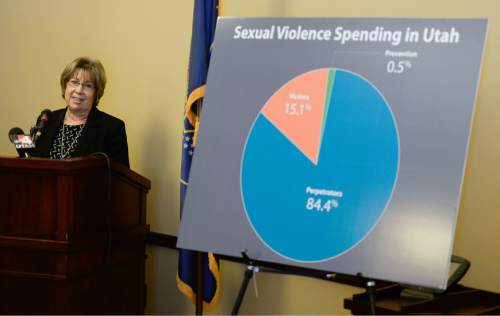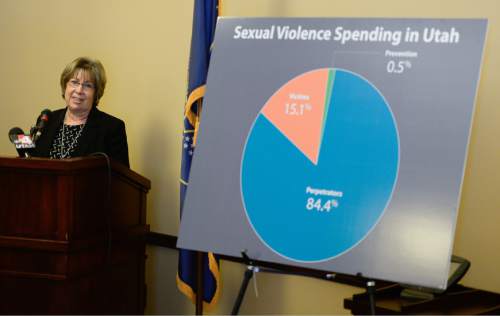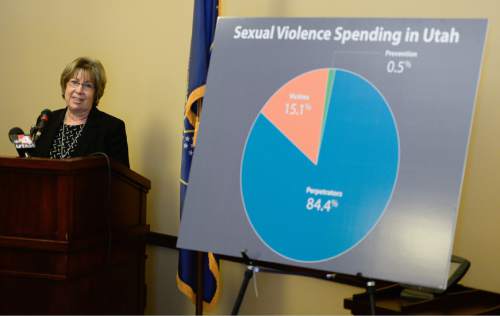This is an archived article that was published on sltrib.com in 2016, and information in the article may be outdated. It is provided only for personal research purposes and may not be reprinted.
Rape is more than a public health or safety issue in Utah. It's also a financial one.
Sexual assaults cost the state $4.8 billion in 2011 — equal to 40 percent of the state budget for that year — a new report estimates.
"The numbers are absolutely staggering," said Ron Gordon, executive director of the Commission on Criminal and Juvenile Justice. "Even so, they're not enough to quantify the effect of sexual violence."
And because few assaults are reported, the real price tag may be much larger, said Gordon and fellow advocates at a Wednesday news conference at the Capitol.
The Utah Department of Health hopes the financial strain will put the problem of sexual assault on the minds of the public and lawmakers as the 2016 Legislature convenes in two weeks. Each instance of sexual assault cost the state about $1,700 per resident in 2011, the report found.
Some of the burden falls on hospitals, police departments and courts. But the most costly component stems from medical bills, lost wages and long-term emotional tolls, according to the report. The analysis from the Utah Department of Health and the Utah Coalition Against Sexual Assault was released Wednesday. Suffering and reduced quality of life, it said, accounted for 80 percent of the total damage.
The loss is personal for DeAnn Tilton. Tilton's father sexually abused her throughout her childhood, she told the 50 or so people who attended the news conference. Later, as a college student at the University of Utah, she was raped twice.
Tilton was accepted to a social psychology master's program at Ball State University in Indiana at age 23, but the trauma left her too afraid to go.
"I really couldn't function," said Tilton, who eventually earned the master's degree from the U. in August, about 25 years after Ball State's offer. "I couldn't leave the state for something I desperately wanted."
In addition to missing out on decades of higher pay, she was hospitalized for bulimia — a mechanism she used to cope with the assaults, she said.
Sexual violence "causes substantial financial damage," says the report, "to the victims, their families and society as a whole."
And it is not uncommon.
In Utah, 1 out of 8 Utah women is raped in her lifetime, a 2008 state study found.
For men, the statistic is 1 in 50.
"It's concerning. Our homicide rate is seventh lowest, but our rape rate is ninth highest," said Teresa Brechlin, injury-prevention coordinator at the Utah Department of Health, citing FBI data.
The state should "vigorously" adopt new policies, the report says, to target more teens with lessons on healthy relationships and help them identify an adult they can talk to and trust.
The report also reveals "dramatic differences" in where money is spent in the wake of a sexual assault. In 2011, $92 million was spent on perpetrators of sexual violence, while $16 million went to victims. Less than $600,000 went to prevention efforts.
Funding to address sexual assault grew in 2013 after a statewide tally revealed that 2,700 envelopes of evidence collected by nurses — possibly containing swabs, blood, semen, hair or clothing samples — had not been reviewed by a crime lab. The Legislature spent $750,000 to address the backlog.
Last year, lawmakers tweaked state law to clarify that sleeping or incapacitated people cannot consent to sex — a measure that drew national attention after one Utah lawmaker suggested he believed consent could be implied.
There is another effort this year to bring justice to more victims from one Utah lawmaker hoping to update the criminal code. A legislative proposal from Democratic Salt Lake City Rep. Angela Romero says mistakenly believing a victim to be 18 years old should not be allowed as a defense against criminal charges of human trafficking a child.
About 20,600 Utahns were raped in 2011, the report found; four out of five times, the victim was female.
The assaults led to more than 1,000 pregnancies and 5,000 cases of sexually transmitted diseases, as well as drug and alcohol abuse.
Researchers modeled the Utah study after similar ones in Minnesota and Iowa. They used state data and also adjusted the national figures to Utah levels.
Twitter: @anniebknox









